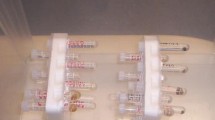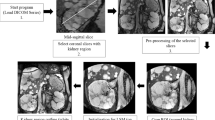Abstract
Purpose
Decision support systems for imaging analysis and interpretation are rapidly being developed and will have an increasing impact on the practice of medicine. RENEX is a renal expert system to assist physicians evaluate suspected obstruction in patients undergoing mercaptoacetyltriglycine (MAG3) renography. RENEX uses quantitative parameters extracted from the dynamic renal scan data using QuantEM™II and heuristic rules in the form of a knowledge base gleaned from experts to determine if a kidney is obstructed; however, RENEX does not have access to and could not consider the clinical information available to diagnosticians interpreting these studies. We designed and implemented a methodology to incorporate clinical information into RENEX, implemented motion detection and evaluated this new comprehensive system (iRENEX) in a pilot group of 51 renal patients.
Methods
To reach a conclusion as to whether a kidney is obstructed, 56 new clinical rules were added to the previously reported 60 rules used to interpret quantitative MAG3 parameters. All the clinical rules were implemented after iRENEX reached a conclusion on obstruction based on the quantitative MAG3 parameters, and the evidence of obstruction was then modified by the new clinical rules. iRENEX consisted of a library to translate parameter values to certainty factors, a knowledge base with 116 heuristic interpretation rules, a forward chaining inference engine to determine obstruction and a justification engine. A clinical database was developed containing patient histories and imaging report data obtained from the hospital information system associated with the pertinent MAG3 studies. The system was fine-tuned and tested using a pilot group of 51 patients (21 men, mean age 58.2 ± 17.1 years, 100 kidneys) deemed by an expert panel to have 61 unobstructed and 39 obstructed kidneys.
Results
iRENEX, using only quantitative MAG3 data agreed with the expert panel in 87 % (34/39) of obstructed and 90 % (55/61) of unobstructed kidneys. iRENEX, using both quantitative and clinical data agreed with the expert panel in 95 % (37/39) of obstructed and 92 % (56/61) of unobstructed kidneys. The clinical information significantly (p < 0.001) increased iRENEX certainty in detecting obstruction over using the quantitative data alone.
Conclusion
Our renal expert system for detecting renal obstruction has been substantially expanded to incorporate the clinical information available to physicians as well as advanced quality control features and was shown to interpret renal studies in a pilot group at a standardized expert level. These encouraging results warrant a prospective study in a large population of patients with and without renal obstruction to establish the diagnostic performance of iRENEX.

Similar content being viewed by others
References
Woolfson RG, Neild GH. The true clinical significance of renography in nephro-urology. Eur J Nucl Med. 1997;24:557–70.
Kletter K, Nurnberger N. Diagnostic potential of diuresis renography: limitations by the severity of hydronephrosis and by impairment of renal function. Nucl Med Commun. 1989;10:51–61.
Upsdell SM, Leeson SM, Brooman PJ, O’Reilly PH. Diuretic-induced urinary flow rates at varying clearances and their relevance to the performance and interpretation of diuresis renography. Br J Urol. 1988;61:14–8.
Kuyvenhoven J, Piepsz M, Ham H. When could the administration of furosemide be avoided? Clin Nucl Med. 2003;28:732–7.
Brown SC, Upsdell SM, O’Reilly PH. The importance of renal function for the interpretation of diuresis renography. Br J Urol. 1992;69:121–5.
Chaiwatanarat T, Padhy AK, Bomanji JB, Nimmon CC, Sonmezoglu K, Britton KE. Validation of renal output efficiency as an objective quantitative parameter in the evaluation of upper urinary tract obstruction. J Nucl Med. 1993;34:845–8.
Schlotmann A, Clorius JH, Clorius SN. Diuretic renography in hydronephrosis: renal tissue tracer transit predicts functional course and thereby need for surgery. Eur J Nucl Med Mol Imaging. 2009;36:1665–73. doi:10.1007/s00259-009-1138-5.
O’Reilly P, Aurell M, Britton K, Kletter K, Rosenthal L, Testa T. Consensus on diuresis renography for investigating the dilated upper urinary tract. J Nucl Med. 1996;37:1872–6.
O’Reilly PH; Consensus Committee of the Society of Radionuclides in Nephrology. Standardization of the renogram technique for investigating the dilated upper urinary tract and assessing the results of surgery. BJU Int. 2003;91:239–43.
Taylor AT, Blaufox MD, De Palma D, Dubovsky EV, Erbaş B, Eskild-Jensen A, et al. Guidance document for structured reporting of diuresis renography. Semin Nucl Med. 2012;42(1):41–8.
Garcia EV, Taylor A, Halkar R, Folks R, Krishnan M, Cooke CD, et al. RENEX: an expert system for the interpretation of 99mTc-MAG3 scans to detect renal obstruction. J Nucl Med. 2006;47(2):320–9.
Taylor A, Garcia EV, Binongo JN, Manatunga A, Halkar R, Folks RD, et al. Diagnostic performance of an expert system for interpretation of 99mTc MAG3 scans in suspected renal obstruction. J Nucl Med. 2008;49:216–24.
Taylor Jr A, Corrigan PL, Galt J, Garcia EV, Folks R, Jones M, et al. Measuring technetium-99m-MAG3 clearance with an improved camera-based method. J Nucl Med. 1995;36:1689–95.
Folks RD, Garcia EV, Taylor AT. Development and prospective evaluation of an automated software system for quality control of quantitative 99mTc-MAG3 renal studies. J Nucl Med Technol. 2007;35:27–33.
Folks RD, Manatunga D, Garcia EV, Taylor AT. Automated patient motion detection and correction in dynamic renal scintigraphy. J Nucl Med Technol. 2011;39:131–9.
Taylor A, Manatunga A, Morton K, Reese L, Prato FS, Greenberg E, et al. Multicenter trial validation of a camera-based method to measure Tc-99m mercaptoacetyltriglycine, or Tc-99m MAG3, clearance. Radiology. 1997;204:47–54.
Shortliffe EH. Computer-Based Medical Consultations: MYCIN. Amsterdam: Elsevier Scientific; 1976. p. 264.
Dunn OJ. Basic statistics: a primer for the biomedical sciences. New York: Wiley; 1977. p. 116–9.
Garcia EV, Taylor A, Manatunga D, Folks R. A software engine to justify the conclusions of an expert system for detecting renal obstruction on 99mTc-MAG3 scans. J Nucl Med. 2007;48:463–70.
Binongo JN, Manatunga A, Taylor AT. Computer-aided diagnosis of renal obstruction: utility of log-linear modeling versus standard ROC and kappa analysis. EJNMMI Res. 2011;1:1–8.
Gordon I, Colarinha P, Fettich J, Fischer S, Frökier J, Hahn K, et al. Guidelines for standard and diuretic renography in children. Eur J Nucl Med. 2001;28:BP21–30.
Eskild-Jensen A, Gordon I, Piepsz A, Frøkiær J. Interpretation of the renogram: problems and pitfalls in hydronephrosis in children. BJU Int. 2004;94:887–92.
Howman-Giles R, Uren R, Roy LP, Filmer RB. Volume expansion diuretic renal scan in urinary tract obstruction. J Nucl Med. 1987;28:824–8.
Peters AM. Graphical analysis of dynamic data: The Patlak-Rutland plot. Nucl Med Commun. 1994;15:669–72.
Acknowledgments
This work was supported by the US National Institute of Biomedical Imaging and Bioengineering, and the National Institute of Diabetes and Digestive and Kidney Diseases, R01-EB008838.
Conflicts of interest
E.G., R.F. and A.T. receive royalties from the sale of the application software QuantEM™ related to the research described in this article. The terms of this arrangement have been reviewed and approved by Emory University in accordance with its conflict-of-interest practice.
Author information
Authors and Affiliations
Corresponding author
Rights and permissions
About this article
Cite this article
Garcia, E.V., Taylor, A., Folks, R. et al. iRENEX: a clinically informed decision support system for the interpretation of 99mTc-MAG3 scans to detect renal obstruction. Eur J Nucl Med Mol Imaging 39, 1483–1491 (2012). https://doi.org/10.1007/s00259-012-2151-7
Received:
Accepted:
Published:
Issue Date:
DOI: https://doi.org/10.1007/s00259-012-2151-7




